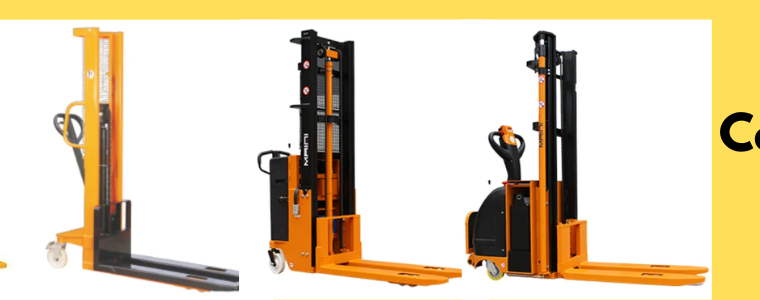Introduction to Choosing The Right Pallet Stacker
Choosing the right pallet stacker is crucial for efficient warehouse operations. With various options available, understanding the differences can help you make an informed decision. This guide will explore the types of pallet stackers, key features to consider, and maintenance tips to ensure you select the best equipment for your needs.
Types of Pallet Stackers
Electric Pallet Stackers
Electric pallet stackers are powered by batteries, making them ideal for larger warehouses with heavy lifting requirements. They offer higher efficiency and ease of use, reducing physical strain on operators. These stackers are equipped with advanced features such as precise controls and adjustable forks, allowing for seamless operation. The primary advantage of electric pallet stackers is their ability to handle substantial loads with minimal effort, making them suitable for businesses with high-volume material handling needs.
Manual Pallet Stackers
Manual pallet stackers, also known as hand stackers, are operated by hand or foot pumps. They are more affordable and require no power source, making them suitable for smaller warehouses or operations with lighter loads. While they lack the convenience of electric models, manual stackers offer precise control and are easier to maintain. They are a cost-effective solution for businesses with limited material handling needs, providing a balance between functionality and affordability.
Semi-Electric Pallet Stackers
Semi-electric pallet stackers combine the features of both manual and electric models. They typically have an electric lift mechanism while the movement is manually controlled. This hybrid approach offers the advantage of reduced operator fatigue without the higher cost of fully electric stackers. Semi-electric stackers are ideal for medium-sized warehouses where some automation is needed but full electric functionality is not required.
Key Features to Consider
Load Capacity
The load capacity of a pallet stacker determines the maximum weight it can handle. It’s essential to choose a stacker with a capacity that meets your warehouse’s needs. Overloading a stacker can lead to equipment damage and safety hazards. Evaluate the typical load weights in your operations and select a stacker that can handle slightly more than the maximum weight you plan to lift regularly.
Lift Height
Lift height is another critical factor. This refers to the maximum height a stacker can raise a load. Consider the height of your storage racks and ensure the stacker can reach the topmost levels. Selecting a stacker with an appropriate lift height can optimize space utilization and improve overall efficiency in your warehouse.
Maneuverability
Maneuverability is crucial, especially in tight spaces or narrow aisles. Look for features like compact design, tight turning radius, and responsive controls. A stacker with excellent maneuverability enhances operational efficiency and reduces the risk of accidents or damage to goods.
Power Source
The power source of a pallet stacker impacts its performance and operational costs. Electric stackers are more powerful and suitable for continuous use, while manual stackers are cost-effective and require less maintenance. Consider your budget and usage frequency when deciding on the power source. Semi-electric stackers offer a middle ground, providing some level of automation without the higher cost of fully electric models.
Benefits of Using Pallet Stackers
Pallet stackers enhance warehouse operations by increasing efficiency and reducing manual labor. They improve safety by minimizing the physical strain on workers and reducing the risk of injuries. Pallet stackers also optimize space utilization, allowing for better organization and faster access to goods. By investing in the right pallet stacker, businesses can boost productivity, ensure worker safety, and ultimately save on labor costs.
How to Choose the Right Pallet Stacker for Your Business
Choosing the right pallet stacker involves assessing your warehouse’s specific needs. Start by evaluating the types of goods you handle, the weight and size of loads, and the layout of your warehouse. Consider the frequency of use and the operator’s skill level. It’s also important to factor in budget constraints and long-term maintenance costs. Consulting with a reputable supplier can provide valuable insights and help you make an informed decision. Test different models if possible to ensure they meet your operational requirements.
Maintenance Tips for Pallet Stackers
Regular maintenance is crucial for the longevity and performance of your pallet stacker. Follow the manufacturer’s guidelines for routine inspections and servicing. Check for any signs of wear and tear, such as damaged forks, worn-out wheels, or hydraulic leaks. Keep the stacker clean and lubricate moving parts to ensure smooth operation. Battery maintenance is essential for electric stackers – ensure proper charging cycles and check battery health regularly. Scheduling periodic professional servicing can help detect and address issues before they become major problems.
Conclusion



